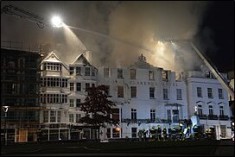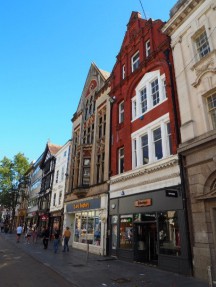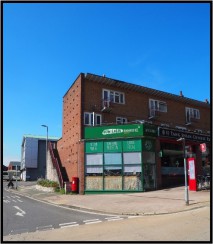
Fire in Exeter
with Dr. Todd Gray on Wednesday, 13 December 2023
at 7pm at the Mint Methodist Church Centre, Exeter
Todd Gray began his talk by highlighting the most serious fire in Exeter since WW2, that of the Royal Clarence Hotel on 28 October 2016, which is still awaiting rebuilding, but is hopefully on the verge of work finally taking place. For this talk Todd concentrated on a specific section of his new book, Exeter’s Lost Buildings: Destruction from 1800 to 1899. To quote from a passage in this section: “No nineteenth-century instances have been found in which fire caused the destruction of a building in the cathedral precinct other than at Little Style, but it was the principal reason for the loss of dozens of buildings in other parts of Exeter” The city’s most famous fire destroyed the theatre in 1887, but fire was not the cause of near-complete destruction as happened in such Devon towns as Chudleigh (1807), Crediton (1743) or Tiverton (1598, 1612 and 1731). Instead, most of the buildings lost to fire in Exeter came through individual outbreaks. Fire was the greatest factor for loss in Fore Street but less prevalent elsewhere. Prevention was aided by the early use of slates for roofs. In the early 1600s the Chamber forbade the use of thatch or straw for buildings and into the 1830s the city’s Mace Sergeants received six pence for every chimney fire they reported. Exeter’s last thatch building, which was outside the walls, was taken down in 1882: it was situated near St Sidwell’s Church.”
Todd spoke about fires which occurred mostly in Fore Street, High Street, South Street and North Street and gave several examples, some of which are mentioned here.
Fore Street
Nos. 97 & 98, (1826) [currently Blue Banana and Rooster Records] Todd records that “On 31 July 1826 fire broke out in these adjoining buildings.” No 97 was occupied by Richard Evans, a chemist and druggist and the building was described in 1801 as being “opposite the old French Church (St Olave)”. A second fire struck in 1884 when Robert Tosswill, a grocer, occupied the lower half of No. 98 from 1814.
No. 130 (Scotland House), 1853 [corner of Fore and West Streets, currently Rochell’s, Curtains, Blinds and Foam] Fire completely destroyed the building and the site was vacant for fourteen years. An unusual feature of this fire concerned Joseph Smith a young man who was related to the occupants and had died of tuberculosis. His coffin was lying at rest on the third storey of the building and when fire destroyed the floor joists, the coffin plunged to the ground floor and burst open but the corpse was recovered the following day “and found to be only slightly singed”. The fire occurred on 23 November 1853 caused by a faulty gas apparatus. The building was occupied by a firm of drapers. “No 130 had been known as Scotland House from at least 1827 until 1924.”
Nos. 99 to 101, (1876) [across from St Olave’s Church, currently The Music Depot, more recently an Australian themed pub The Walkabout Inn, and what this author remembers as The Remnant Shop – next door up from 102 Thomas Moore] A fire broke out on 26 March 1876 and destroyed two ‘old-fashioned houses. No. 101 was sold in 1877 and Todd notes that in 1879 “a building was erected for the Devon & Exeter Coffee Tavern, the first establishment of its kind in Exeter. It opened on 12 April and comprised billiard and bagatelle rooms on the ground floor and a large hall on the first floor. It was subsequently occupied by the Franklin Temperance Hotel.”
Nos. 162 & 163 (Exeter Hall), 1876 [adjoining St Olave’s Church, currently EX4. In 1981 they had been occupied by Manders, paint & wallpaper merchants and Electrosure electrical and hi-fi equipment]. Todd notes that this building had suffered two fires and the second one caused minor damage to St Olave’s Church, the Mint Methodist Church and surrounding buildings. It had been used by a chandler who stored oil and tallow in a rear warehouse. “The building was known variously as Devon & Exeter Hall, Exeter Hall, Tuckett’s Hall and Tuckett’s Great Room.” “Nicholas Tuckett (c.1785-1852), initially a chandler but later a timber, slate, guano, tallow and general merchant, provided it for use as a Free Church in 1844, but two years later it was reused for public lectures and an auction mart.”
Corner of Fore and North Streets
Nos. 176 to 186 (and Nos. 1 to 8 North Street), 1882 [currently the shops which replaced British Home Stores, Brocks Furnishers, and Cornish’s and in North Street down to Hexter’s Vaults public house and Long Bar] Todd notes that “two fires in January and July 1882 damaged or destroyed a dozen buildings, estimated to cover more than half an acre, situated around the corner of Fore and North Streets”. Probably the most memorable building in this author’s lifetime was the Cornish’s building selling school uniforms which was known as Paternoster House and its rather cramped lift to the upper floors operated by a uniformed lift operator.
High Street
Nos. 55 to 58 (1881) [opposite the Guildhall, currently Card Factory and Finistere (formerly Lush)] The pair of buildings was destroyed by fire on the night of 9 October 1881 and rebuilt by Wippell & Company, ecclesiastical furnishers. Todd notes that “Nos. 55 and 56 had been the Eagle, the early nineteenth-century hospitium which was later used as a cloth hall.” The building’s most frequent use was that of book sellers, most notably by the Dyer family and its reputation of having a secret room which had to be kept locked. Rebuilding of Nos. 57 and 58 was complicated by the city council deeming that the first floor window projected further into the street (by a fraction of an inch) than it should have done, and decreed that it had to be removed and replaced.
South Street, also known as South Gate Street
No. 78 (Black Lions Inn), 1873 South Street sustained widespread damage during the Blitz of May 1942 but the location of the former No. 78 would have been towards the bottom of South Street between Coombe and Sun Streets. Todd quotes Jenkins describing the building in 1806 as: “‘a very ancient building, and from its appearance, seems to have been erected for monastic purposes. It occupies a large spot of ground in the front, which was a few years since rebuilt, is an antique carving representing an angel holding a shield, on which is inscribed the date of 1421 [sic], in ancient characters.’ In 1853 members of the Literary Society were told that one of the earliest uses of Arabic numerals in England was this date over the doorway of the Black Lions. The actual date was 1621.” The building had been used as a hostelry since at least 1699 and “the city’s Southern Conservative Society met at the inn from the 1830s to the 1850s” and had a reputation of “quilling” (essentially bribery) where potential electors enjoyed being supplied with copious amounts of food and drink to secure their votes in local elections. Todd writes that “It was still running as an inn when on the evening of 21 September 1873 fire broke out and tore through the building. One commentator noted that few fires completely destroy buildings as intensely as that had the Black Lions: the frontage had been destroyed as had the building’s interior.”
Conclusion
This write-up contains a small snippet of what Todd showed us and much more information can be found in the book, along with reasons other than fire for the destruction of buildings within the city walls in the 1800s, including the sweeping away of buildings in the Cathedral Precinct because it was deemed they spoilt the view of the Cathedral, the actions of the Improvement Commission and Streets Committee which ordered that the frontage of buildings be cut back for road widening purposes and also because of current fashions and commercial development.
[written by Sue Jackson]



